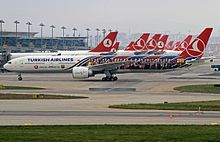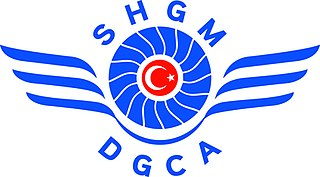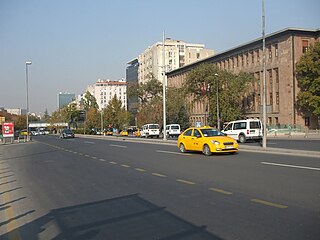This article needs to be updated.(July 2020) |
Turkey is an emerging aviation hub at the intersection of Europe with emerging markets in the Middle East, the Caucasus and Northern Africa. [1]
This article needs to be updated.(July 2020) |
Turkey is an emerging aviation hub at the intersection of Europe with emerging markets in the Middle East, the Caucasus and Northern Africa. [1]

In 1983, the Turkish airline market was liberalized. While before, only public companies were allowed to serve the country's airports, with the enactment of the 1983 Civil Aviation Law, private companies were admitted. As the regulation failed at setting up a competitive environment, the quasi-monopoly of Turkey's national flag carrier Turkish Airlines was further reinforced. It was only in 2003, that major barriers for market entry were erased, leading to a more competitive market, though Turkish Airlines continued to benefit from state support. [2]
As of 2023, Turkish Airlines is one of the major airlines of the world, particularly by its number of international passengers with 83.4 million passengers. [3] Operating scheduled services to 122 countries and 304 destinations all around the world. The Turkish airlines flies to more countries than any other airlines in the world. [4]

Since the 2000s, the country has seen an extraordinary development in civil aviation with a growth ten times faster than the world average. While Turkey's airports only handled 34 million passengers in 2003, the number rose to 105 million in 2010, 52 percent of which were on international flights. [5] In 2012, Turkish airports handled 130 million passengers, making it the sixth-largest aviation market in Europe. [6]
In 2015, Istanbul's Atatürk Airport handled 61.8 million passengers making it the world's 11th busiest airport at the time. [7] The aging airport was however replaced by the larger Istanbul Airport. With the world's largest airport terminal, initially serving 90 million passengers the new airport will massively expand the passenger capacity, with two more terminals being planned summing up to 150 million passengers per year. [8] By 2035, the new airport is projected to be the world’s largest airport serving 260 million passengers annually. [9]
Under Transport Minister Binali Yıldırım, numerous new airports were opened, starting with Zonguldak Airport and Şanlıurfa GAP Airport and the controversial Hatay Airport in 2007. Amasya Merzifon Airport followed in 2008, while Gazipaşa Airport serving Antalya and Gökçeada Airport serving Çanakkale were opened in 2010. Zafer Airport serving the cities of Afyonkarahisar, Uşak and Kütahya in 2012, Iğdır Airport also in 2012 and Şırnak Airport followed in 2013. [10] Erhaç Airport in Malatya and Cengiz Topel Airport in Kocaeli, previously operating as military air bases, were opened to civil aviation in 2007 and 2011 respectively. A new international terminal at İzmir's Adnan Menderes Airport was opened in 2006, followed by a new domestic terminal in 2014. [11] New terminal buildings for Erzincan Airport and Mardin Airport were both opened in 2011 and a new international terminal for Milas–Bodrum Airport was completed in 2012.
In the same period, many other airports were refurbished, [12] including the Tokat, Kahramanmaraş, Sivas, Gaziantep and Çanakkale, Balıkesir and Kars Harakani airports reopened in 2006 and 2007. [13] [14] [15] Major improvements to Balıkesir Koca Seyit Airport and Kastamonu Airport were completed in 2010 and 2013 respectively.
In the airport sector, construction company Limak İnşaat grew into the position as one of the regional market leaders. In 2007, a Limak joint venture with French company Aéroport de Lyon won the concession tender for Pristina International Airport Adem Jashari. [16] In 2015, the company won the tender for a new terminal building at Kuwait International Airport. [17] Limak is also part of the joint venture that won the tender for Istanbul Airport, Turkey's largest PPP infrastructure project, and due to become the world's largest airport. [8]

Turkey has sought for a national aerospace industry since the foundation of the Republic. Under the auspices of the Turkish Ministry for Industry and Technology, Turkey's aircraft industry today is centered on the Turkish Aerospace Inc. (TAI) - founded in 1984 - expanding on a predecessor established in 1973, [18] and Tusaş Engine Industries (TEI). Several indigenous fighter aircraft programs are under development, the most ambitious of which is the air superiority fighter TAI KAAN (started in 2011) for the Turkish Air Force and future export purposes. TAI produces the trainer and light combat aircraft TAI Hürkuş and TAI Hürjet, the attack helicopter T129 ATAK, the UAVs TAI Anka and TAI Aksungur, and several reconnaissance and military satellites such as the Göktürk-3. The private company Baykar is known for its proven tactical UAV Bayraktar TB2.

Transport in Turkey is road-dominated and mostly fuelled by diesel. Transport consumes a quarter of energy in Turkey, and is a major source of air pollution in Turkey and greenhouse gas emissions by Turkey. The World Health Organization has called for more active transport such as cycling.

Atatürk Airport was the primary international airport of Istanbul until it was closed to commercial passenger flights on 6 April 2019. From that point, all flights were transferred to the new Istanbul Airport. All freight operations subsequently relocated as well by 5 February 2022 after which the airport continued to serve general aviation until its final closure. It used to be the hub of Turkish Airlines; however, it is now only in use for private jets.

İzmir Adnan Menderes Airport is an international airport serving İzmir and most of the surrounding province in Turkey. It is named after former Turkish prime minister Adnan Menderes.

Ankara Esenboğa Airport is the international airport of Ankara, the capital city of Turkey. It has been operating since 1955. In 2017, the airport has served more than 15 million passengers in total, 13 million of which were domestic passengers. It ranked 4th in terms of total passenger traffic, 3rd in terms of domestic passenger traffic among airports in Turkey. The airport was ranked 22nd in the "100 Things That Give Hope in Turkey" list published in the 100th issue of Newsweek Turkey magazine.
Mount Bolu Tunnel is a 3.1-kilometre-long (1.9 mi) highway tunnel constructed through the Bolu Mountain in Turkey between Kaynaşlı, Düzce and Yumrukaya, Bolu.

Adana Airport or Adana Şakirpaşa Airport is an international airport located in Adana, Turkey. The airport serves mainly to Cilicia region and in a lesser extent to the provinces surrounding Cilicia, due to its frequent domestic flight schedule and several flights to international destinations. With 5.1 million passengers in 2019, it is the sixth-busiest airport in Turkey. Opened in 1937, Şakirpaşa Airport is the oldest airport in Turkey that is still in public service.

Kahramanmaraş Airport is an airport in Kahramanmaraş, Turkey.

Binali Yıldırım is a Turkish politician who served as the 27th and last prime minister of Turkey from 2016 to 2018 and Speaker of the Grand National Assembly from 2018 to 2019. He was Leader of the Justice and Development Party (AKP) from 2016 to 2017, then becoming parliamentary leader until 2018.

Nevşehir Kapadokya Airport is an airport serving, and located 30 kilometres (19 mi) in the northwest of, Nevşehir, Turkey.

Atlasjet Flight 4203 was a scheduled domestic passenger flight from Istanbul Atatürk Airport in Istanbul to Isparta Süleyman Demirel Airport in Isparta Province, Turkey. On 30 November 2007, the aircraft operating the flight – a McDonnell Douglas MD-83 which Atlasjet had leased from World Focus Airlines just five months before – crashed in the vicinity of Keçiborlu between the villages of Yenitepe and Çukurören while on approach, approximately 12 kilometres (7.5 mi) west of the destination airport. The flight had taken off from Istanbul at 00:51 EET with 50 passengers and 7 crew members on board. All 57 occupants perished in the accident.
Ankara Güvercinlik Army Air Base, is a military airport of the Turkish Army located in Güvercinlik of Etimesgut district, 10 km (6.2 mi) west of Ankara in central Turkey.

Istanbul Sabiha Gökçen International Airport is one of two international airports serving Istanbul, the largest city in Turkey. Located 32 km (20 mi) southeast of the city center, Sabiha Gökçen Airport is in the Asian part of the bi-continental city and serves as the hub for AnadoluJet and Pegasus Airlines. The facility is named after Sabiha Gökçen, adoptive daughter of Mustafa Kemal Atatürk and the first female fighter pilot in the world. Although Istanbul Airport, located 63 km (39 mi) west of the European side of Istanbul, is larger, Sabiha Gökçen is still one of the largest airports in the country.

The Directorate General of Civil Aviation is the aviation regulator for Turkey. The organization formed in 1954 and handles the registration of Unmanned aerial vehicles and civil aircraft. The organization also conducts the investigations of aviation accidents in the airspace of Turkey.
Çukurova Regional Airport is a projected airport being built in the Tarsus district of Mersin Province, southern Turkey. It will serve the provinces of Mersin and Adana, as well as the rest of the region of Çukurova. It most likely will be continuing all and more destinations from its predecessor, Adana Şakirpaşa Airport, including its IATA code of 'ADA'.

Istanbul Airport is the larger of two international airports serving Istanbul, Turkey. It is located in the Arnavutköy district on the European side of the city.
Hakkari–Yüksekova Selahaddin Eyyubi Airport is a public airport in Yüksekova, a town in Hakkari Province, Turkey.

The Kızılada Lighthouse is an historical lighthouse still in use, which is located on the island Kızılada in the Gulf of Fethiye, southwestern Turkey.

Gazi Mustafa Kemal Boulevard, abbreviated as GMK Boulevard, is a boulevard connecting Anadolu Square in Yenimahalle with Kızılay Square in Çankaya of Ankara, Turkey. The 2.2 km (1.4 mi) long boulevard runs in northwest–southeast direction. It is named after Mustafa Kemal Atatürk (1881–1938), the founder of Turkish Republic.

Ankara Tren Garı, alternatively known as Ankara YHT railway station and abbreviated as ATG, is a mixed-use commercial building in Ankara, Turkey. The building houses a shopping mall, a five-star hotel and commercial offices, as well as a concourse for YHT high-speed trains.
By 2035, the New Airport should serve 260 million passengers annually, making it the world's largest airport, Turkish Airlines president and CEO Temel Kotil told ATW."Kotil: Istanbul New Airport to be world's largest | Airports & Routes content from ATWOnline". Archived from the original on 2016-04-23. Retrieved 2016-04-23.
{{cite web}}: CS1 maint: bot: original URL status unknown (link)